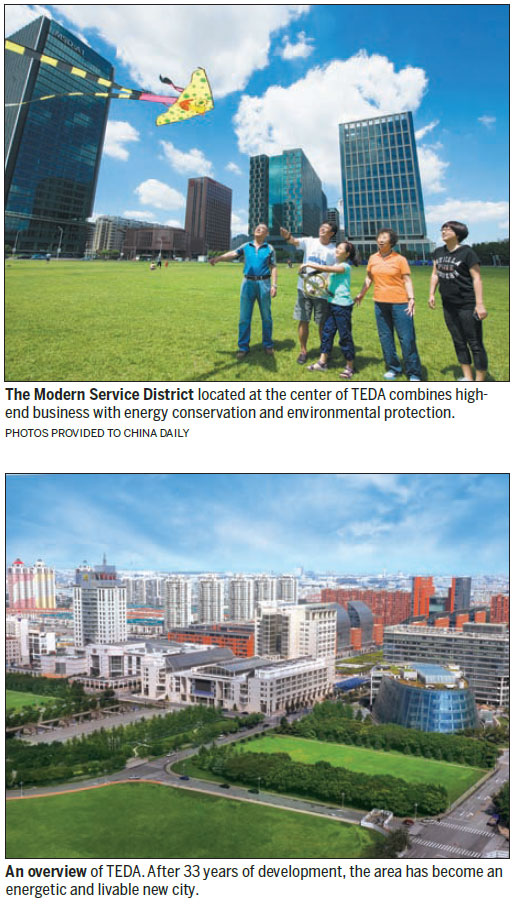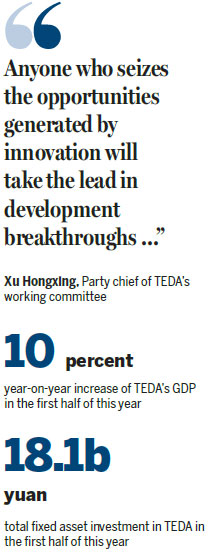TEDA leads the charge toward higher value-added production

Tianjin Economic-Technological Development Area (TEDA), one of the first national development zones in China, has experienced significant innovation-driven development and industrial advancement in recent years.
Manufacturing has been an industry pillar both in Tianjin and across China for several decades. However, the sector faces great challenges due to pressures such as rising costs, high energy consumption and pollution.
In May last year, the central government released its "Made in China 2025" blueprint, which aims to improve manufacturing and shift the country away from low-end manufacturing to more value-added production.
TEDA has echoed the initiative's call and seized the opportunity: It has attracted foreign investment to develop modern manufacturing and diversify its industries.
In the first half of this year, the area's GDP increased by more than 10 percent year-on-year. The area's fixed asset investment totaled 18.1 billion yuan ($2.62 billion), materialized foreign investment reached $1.66 billion and domestic investment reached 14.5 billion yuan in the first half of the year. There are 21 ongoing projects in the area, each with investment of at least $10 million.
Founded in December 1984, the area's major industries generated output of 805 billion yuan in 2013, increasing to 820 billion yuan last year, according to the area's statistics bureau.
During the 13th Five-Year Plan period (2016-20), its major industries' output is expected to reach 1.3 trillion yuan, according to a recently released industrial development plan.
Innovation drive
Enterprises in the area have upgraded their technology and improved production efficiency in the pursuit of more innovation-driven growth.
Tingyi (Cayman Islands) Holding Corp, a Chinese food and beverage manufacturer founded 26 years ago in the area, has invested in highly automated production lines.
Likewise, in the workshops of furniture manufacturer Markor International Furnishings Co, young workers operate advanced industrial robots.
"With the robots, we not only cut human resources costs, but also increased our production efficiency threefold," said Xu Hai, manager of intelligent manufacturing at the company.
"Anyone who seizes the opportunities generated by innovation will take the lead in development breakthroughs, like the forerunners at the beginning of the reform and opening-up that started more than three decades ago," said Xu Hongxing, Party chief of TEDA's working committee, at the Forum on Development Zones of China, held in the area from Aug 19 to 20.
Improved service
To cope with the area's booming industrial development, the local government has improved the efficiency of its services. The government has streamlined administrative approval procedures and integrated offline and online services.

TEDA has also taken steps to assist in the transformation of small and medium-sized enterprises since 2005.
Sun Qijun, deputy head of the area's trade development bureau, said the government has been improving the capabilities of the enterprises and supporting the growth of technology-based startups throughout the past decade.
Last year, the area issued incentives for such enterprises and will grant 15 million yuan every year for their development and maintenance.
The government has helped 307 microenterprises and SMEs secure 33.2 billion yuan in loans this year.
By the end of August, 1,066 enterprises' applications for transformation and upgrades had been approved by the government. Some of the enterprises turned to emerging strategic industries, modern service industries or e-commerce for growth opportunities.
Diversified industries
TEDA has paid great attention to attracting high-quality foreign investment for the development of modern manufacturing, while boosting service industries with high added value since the beginning of the century.
A number of leading enterprises, including Great Wall Motors Co Ltd, have emerged over recent years.
The medium-sized Long March 7 rocket, which was launched from the Wenchang Space Launch Center in South China's Hainan province in June, was assembled in the area.
TEDA has also been promoting the real-world application of technology, transferring technological achievements into real-life productivity.
Several major research facilities have been built in the area over the past decade, including the National Supercomputing Center of Tianjin and the Tianjin International Joint Academy of Biotechnology and Medicine.
The area has built 15 incubation bases for startups, with their total dedicated area reaching 1.05 million square kilometers.
Another 16 bases for innovation and entrepreneurship have been built or are currently under construction in the area.
There are more than 5,500 technology-focused SMEs in the area, including well-known industry players such as Tianjin Motimo Membrane Technology Co Ltd and Tianjin CanSino Biotechnology Inc.
The number of such enterprises is expected to exceed 10,000 by 2020, according to the administrative committee of the area.
Over the next five years, TEDA will speed up development of its financial services and modern commerce, with the added value of each projected to exceed 30 billion yuan.
The added value of another four industries - modern logistics, business services, information services and technology services - is expected to surpass 15 billion yuan by 2020.
Wang Sheng, head of TEDA's administrative committee, said the most crucial task for the area is to develop the real economy and catch up with developed countries in labor productivity.
To become a high-end participant in the international division of labor, TEDA needs to transform its growth mode to pursue innovation-driven development and internally driven growth, Wang said.
The committee will strive to build the area into a landmark industrial metropolis with high-quality resources, comprehensive functions and a favorable living environment, he said.
zhuanti@chinadaily.com.cn
(China Daily 12/06/2016 page24)














